Gaudi’s Barcelona
Thursday, 29th April 2010 by Ian Brown
Antonio Gaudi was a Spanish architect who created a number of unique Modernist buildings in the city of Barcelona. His creations were awarded World Heritage status and many are now visible on Street View.
His most famous creation is the Sagrada Família1, a vast and complex Roman Catholic Church that has been under construction now for 128 years!
Work started on the building in 1882 and is currently projected to finish in 2026, a full century after Gaudi's death and subsequent burial within the confines of his masterwork. The 18 towers designed for the structure represent - in increasing height - the twelve Apostles, the four Evangelists, the Virgin Mary and Jesus Christ.
The rear of the building gives a clear look at the intricate detail as well as the contrast between old and new construction.
The ongoing construction hasn't impeded the Sagrada Família's status as a tourist destination, with more than 2 million people visiting each year. And, taking a huge step forward, part of the building will be opened for public worship later this year, with consecration by the Pope scheduled for November. Bing's Bird's Eye view also gives us a good look at the structure:
Gaudi was also commissioned to design a number of homes for some of Barcelona's wealthier residents.
With distinct Moorish influences, Casa Vicens was one of Gaudi's earliest major designs.
Gaudi designed the ceramic tiles which were then manufactured by the merchant who commissioned the house.
It remains a private home so cannot be visited by the public, unlike Palau Güell, for which Street View shows a lineup of visitors along the narrow street.
While the ornate iron gates aren't visible (one is open for the visitors to enter, the other hidden by construction), the elaborate street-level decor can be seen, and looking up gives a good view of the whole building which was comissioned by wealthy industrialist Eusebi Güell.
Casa Calvet has a more conventional design, a result of its location in a historic part of the city (and the fact that it is sandwiched between two similar homes), though Gaudi did manage to include a few intricate touches on the higher reaches of the building.
Casa Batlló goes to the other extreme - a riot of organic shapes and colourful, intricate mosaics.
Locally known as the House of Bones for its skeletal forms, the design is also considered to pay homage to the story of St George and the dragon.
Casa Milà is a larger structure but is similarly adorned with many whimsical elements, including elaborate chimneys and rooftop terraces.
The property had fallen into disrepair over the decades, but has been restored since the allocation of World Heritage status.
Gaudi was also commissioned to design Park Güell - a housing and garden complex proposed by Eusebi Güell - the elaborate entrance of which can be seen on Street View.
While work on the garden progressed, the housing development failed, with only 2 residences being completed. Gaudi and his family lived in one for a time, despite the fact the he hadn't actually worked on that particular building.
The tranquil park is dominated by the large terrace which is surrounded by an undulating bench - the undulations apparently inspired by the impression left by a workman's naked posterior in wet cement!
I'm not sure if the white-statue-busker at the entrance is portraying Gaudi, but he is worth a closer look anyway!
Information about all these locations can be found at Gaudi's Wikipedia page, while the Great Buildings site has many excellent photos.
-
Visited by Google Sightseeing briefly in 2005, and again in 2008 with the launch of Street View in Spain. ↩︎
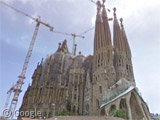
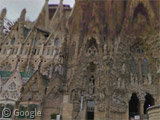

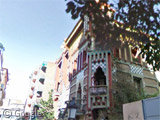
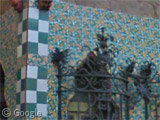
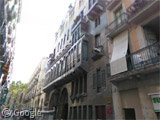
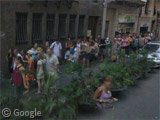
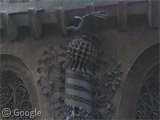
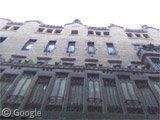
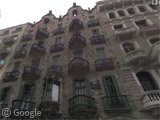
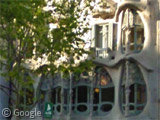
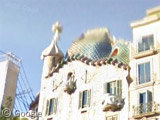
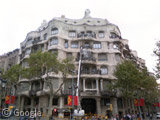
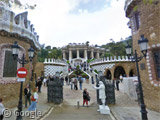
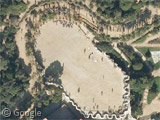
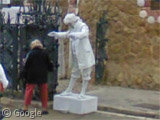
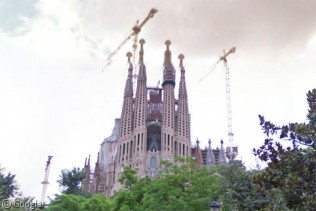
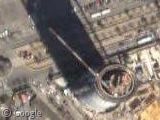
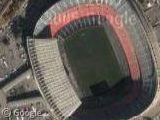
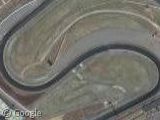
I dont want to be a nauseating pedant but i wouldnt really describe Gaudi as being particularly Modernist (although I admire your correct use of the capital ‘M’) I would argue that Gaudi’s style (overblown and decorative) is everything the Modernists rejected. Yours Dr C. Monster Head of Architectural Pedantry Senior Lecturer in Patronising Internet Posts University of Fraggle Rock
I have to agree with cookie monster: Gaudi’s buildings are absolutely not classically modernist. But although they look a bit like Tim-Burton-esque nightmares from Oz or relics of a weird forgotten past, they were built using (at that time) state of the art methods. They were modern, but not on the surface. Modern, but not modernist. In fact their style is called “Modernisme” which is not the same as modernism. It is more of a derivative of the Art Nouveau movement, but confined to the Barcelona area exclusively.
Oh, by the way: you misspelled his name: Antoni, not Antonio.
Cookie & Kicker – thanks for your input. For both the artistic style and Gaudi’s first name I chose to go with the generally accepted Anglicised versions. I realise that Modernist isn’t the same as Modernisme, but generally, from what I read researching this post, Modernist is the term most used.
I don’t pretend to tag Gaudi’s work. BTW Modernisme is the literal translation for Modernism into Catalan. Here is another Gaudi’s building 25 kms. south from Barcelona: View Placemark,,0,3.8 More info: http://www.gaudiallgaudi.com/AA013.htm